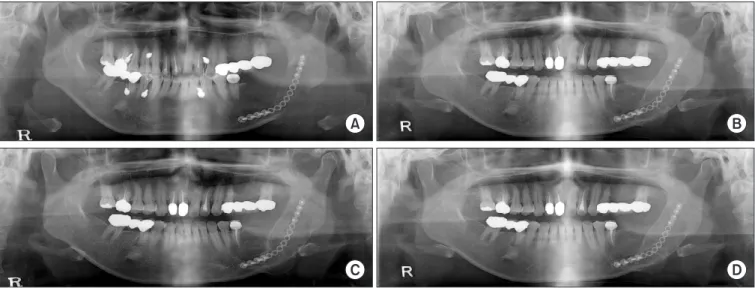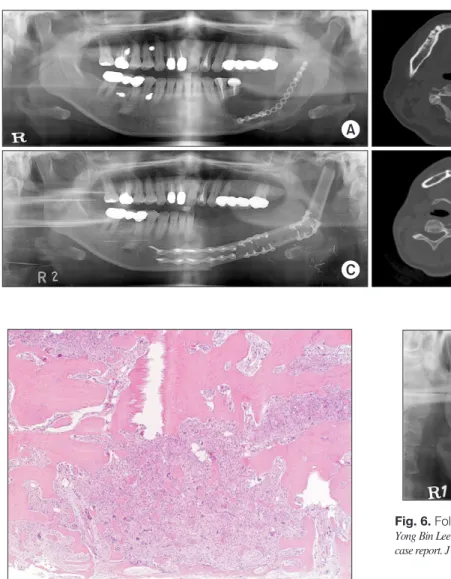48
Low-grade osteosarcoma arising from cemento-ossifying fibroma:
a case report
Yong Bin Lee1, Nam-Kyoo Kim3, Jae-Young Kim4, Hyung Jun Kim1,2
1Department of Oral and Maxillofacial Surgery, 2Oral Cancer Research Institute, Yonsei University College of Dentistry, Seoul, 3Department of Dentistry, Catholic Kwandong University International St. Mary’s Hospital, Incheon,
4Department of Oral and Maxillofacial Surgery, Gangnam Severance Hospital, Yonsei University College of Dentistry, Seoul, Korea
Abstract(J Korean Assoc Oral Maxillofac Surg 2015;41:48-51)
Cemento-ossifying fibromas are benign tumors, and, although cases of an aggressive type have been reported, no cases of cemento-ossifying fibroma transforming into osteosarcoma have been documented previously. Low-grade osteosarcoma is a rare type of primary bone tumor, representing 1%-2% of all osteosarcomas. A 45-year-old female patient was diagnosed with cemento-ossifying fibroma, treated with mass excision several times over a period of two years and eight months, and followed up. After biopsy gathered because of signs of recurrence, she was diagnosed with low-grade osteo-sarcoma. The patient underwent wide excision, segmental mandibulectomy, and reconstruction with fibula free flap. The aim of this report is to raise awareness of the possibility that cemento-ossifying fibroma can transform into osteosarcoma and of the consequent necessity for careful diagnosis and treatment planning.
Key words: Cemento ossifying fibroma, Low-grade osteosarcoma
[paper submitted 2014. 7. 21 / revised 2014. 9. 18 / accepted 2014. 9. 29]
differentiated intramedullary osteosarcomas and parosteal osteosarcomas2. These low-grade osteosarcomas may be
mis-taken for fibro-osseous neoplasms3.
We report a case of low-grade osteosarcoma in the mandi-ble that was transformed from a recurrent cemento-ossifying fibroma. This is the first reported case of the transformation of cemento-ossifying fibroma into malignant low-grade cen-tral osteosarcoma.
II. Case Report
A 45-year-old female patient was referred for a radiolucent lesion of the left posterior mandible, with complaints of a three-month history gingival swelling and tooth pain in the left mandibular second premolar. On intraoral examination, the overlying mucosa was intact with no paresthesia on the left lower lip. Bony swelling was suspected in the left pos-terior vestibule. The second premolar was the vital tooth. A panoramic radiograph showed external root resorption of the second molar and a relatively well-defined radiolucent lesion involving the posterior mandibular body and ramus.(Fig. 1) Computed tomography (CT) imaging showed buccolingual cortical expansion and a soft tissue mass.(Fig. 1) The
sur-I. Introduction
Cemento-ossifying fibromas are benign fibro-osseous tu-mors that are composed of fibrous tissue and a variable mix-ture of calcified materials. They are well-defined unilocular or multilocular lesions with slowly progressing enlargement of the affected bone. The most frequent site is the mandibu-lar premomandibu-lar and momandibu-lar areas, and the tumor has a definite female predilection. Occasionally, it may grow to a massive size and cause serious cosmetic and functional problems, and there are rare reports of lesions behaving in an aggressive fashion1. Low-grade central osteosarcoma is a rare type of
osteosarcoma. In general, osteosarcomas of the jaw are high-grade lesions. Low-high-grade lesions are rare and include
well-CASE REPORT
Hyung Jun Kim
Department of Oral and Maxillofacial Surgery, Yonsei University College of Dentistry, 50 Yonsei-ro, Seodaemoon-gu, Seoul 120-752, Korea
TEL: +82-2-2228-3132 FAX: +82-2-2227-8256 E-mail: kimoms@yuhs.ac
This is an open-access article distributed under the terms of the Creative Commons Attribution Non-Commercial License (http://creativecommons.org/licenses/by-nc/3.0/), which permits unrestricted non-commercial use, distribution, and reproduction in any medium, provided the original work is properly cited.
CC
Copyright Ⓒ 2015 The Korean Association of Oral and Maxillofacial Surgeons. All rights reserved.
http://dx.doi.org/10.5125/jkaoms.2015.41.1.48 pISSN 2234-7550·eISSN 2234-5930
Low-grade osteosarcoma arising from cemento-ossifying fibroma
49 bone, and cementum-like material.(Fig. 2) Conservative mass excision under general anesthesia was performed. The surgi-cal specimen was sent to a pathologist, and the pathologist recommended close follow-up because of the high cellularity of the specimen.
Five months after the first operation, the patient com-rounding soft tissue did not appear to be involved. Under
lo-cal anesthesia, extraction of the second molar was performed, and a biopsy was taken below the extraction socket for his-topathological examination. A hishis-topathological diagnosis of cemento-ossifying fibroma was made. Histopathological examination showed dense fibroblastic proliferation, woven
Fig. 1. Preoperative panorama (A) and
computed tomography (B) show buc-colingual cortical expansion.
Yong Bin Lee et al: Low-grade osteosarcoma aris-ing from cemento-ossifyaris-ing fibroma: a case report. J Korean Assoc Oral Maxillofac Surg 2015
A B
Fig. 2. Preoperative histological image shows woven bone and
cemen-tum-like material (H&E staining, ×40).
Yong Bin Lee et al: Low-grade osteosarcoma arising from cemento-ossifying fibroma: a case report. J Korean Assoc Oral Maxillofac Surg 2015
Fig. 3. Panoramic images after the first operation (A), before the second operation (B), after the second operation (C), and before the third
operation (D).
Yong Bin Lee et al: Low-grade osteosarcoma arising from cemento-ossifying fibroma: a case report. J Korean Assoc Oral Maxillofac Surg 2015
A B
J Korean Assoc Oral Maxillofac Surg 2015;41:48-51
50
first premolar and mass excision were performed under gen-eral anesthesia.(Fig. 3) The pathological diagnosis was the same as previously, but the surgical specimen showed high cellularity and an infiltrative growth pattern into normal bone tissue without mitotic figures or cellular atypia.
Three months after the third operation, tumor recurrence was suspected at the parasymphysis area on follow-up radio-graph (Fig. 4), and a biopsy was taken from the buccal side of the lesion. The specimen showed minimal cellular atypia and irregular bony trabeculae with few mitotic figures (Fig. 5), so a diagnosis of low-grade osteosarcoma was made. No region-al or distant metastasis was shown on magnetic resonance imaging or positron emission tomography-CT imaging. The patient underwent wide excision, segmental mandibulectomy, and reconstruction with fibula free flap.(Fig. 6)
III. Discussion
Cemento-ossifying fibromas are benign fibro-osseous le-sions of the jaw which have been described as demarcated plained of tooth pain in the left mandibular second premolar
and underwent root canal treatment. Periodic follow-up was performed, and there were no signs of recurrence on either clinical or radiographic examination for 16 months. After 16 months, however, follow-up panoramic radiograph and CT displayed signs of recurrence, including a mixed high-attenuation intrabony lesion and a partially multilocular le-sion. Mass excision was performed under local anesthesia, the surgical specimen was submitted for histological exami-nation; the pathological diagnosis was cemento-ossifying fibroma. One year after the second operation, the patient complained of discomfort in the left mandibular canine area, and CT revealed expansion of the lesion and signs of recur-rence. Intentional root canal treatment of the left mandibular
Fig. 4. A, B. Before operation,
panora-ma and computed tomography (CT). C, D. After the final operation, panorama and CT.
Yong Bin Lee et al: Low-grade osteosarcoma aris-ing from cemento-ossifyaris-ing fibroma: a case report. J Korean Assoc Oral Maxillofac Surg 2015
A B
C D
Fig. 5. Final histological image shows bundles of spindle cells with
nuclear hyperchromasia and a variable amount of osteoid and ir-regular bone (H&E staining, ×40).
Yong Bin Lee et al: Low-grade osteosarcoma arising from cemento-ossifying fibroma: a case report. J Korean Assoc Oral Maxillofac Surg 2015
Fig. 6. Follow-up panorama (postoperative day 7 months).
Yong Bin Lee et al: Low-grade osteosarcoma arising from cemento-ossifying fibroma: a case report. J Korean Assoc Oral Maxillofac Surg 2015
Low-grade osteosarcoma arising from cemento-ossifying fibroma
51 insufficient data for evaluating this malignant transformation. However, oral and maxillofacial surgeons should be aware of the rare possibility that cemento-ossifying fibroma can trans-form into osteosarcoma and that careful diagnosis and regular follow-up are required in patients with cemento-ossifying fibromas.
Conflict of Interest
No potential conflict of interest relevant to this article was reported.
References
1. Zupi A, Ruggiero AM, Insabato L, Senghore N, Califano L. Ag-gressive cemento-ossifying fibroma of the jaws. Oral Oncol 2000;36:129-33.
2. Diniz AF, Filho JA, Alencar Rde C, Garcia RR, Silva MR, Ribeiro-Rotta RF, et al. Low-grade central osteosarcoma of the mandible: a case study report. Oral Surg Oral Med Oral Pathol Oral Radiol Endod 2007;103:246-52.
3. Demicco EG, Deshpande V, Nielsen GP, Kattapuram SV, Rosen-berg AE. Well-differentiated osteosarcoma of the jaw bones: a clin-icopathologic study of 15 cases. Am J Surg Pathol 2010;34:1647-55.
4. Peravali RK, Bhat HHK, Reddy S. Maxillo-mandibular cemento-ossifying fibroma: a rare case report. J Maxillofac Oral Surg 2013. doi: 10.1007/s12663-013-0507-6.
5. Trijolet JP, Parmentier J, Sury F, Goga D, Mejean N, Laure B. Cemento-ossifying fibroma of the mandible. Eur Ann Otorhinolar-yngol Head Neck Dis 2011;128:30-3.
6. Hemavathy S, Roy S. Aggressive ossifying fibroma presenting as extensive mandibular swelling: a case report. Indian J Dent 2011;2: 107-12.
7. Toro C, Millesi W, Zerman N, Robiony M, Politi M. A case of ag-gressive ossifying fibroma with massive involvement of the man-dible: differential diagnosis and management options. Int J Pediatr Otorhinolaryngol Extra 2006;1:167-72.
8. Thariat J, Julieron M, Brouchet A, Italiano A, Schouman T, Marcy PY, et al. Osteosarcomas of the mandible: are they different from other tumor sites? Crit Rev Oncol Hematol 2012;82:280-95. 9. Kumar A, Varshney MK, Khan SA, Rastogi S, Safaya R. Low
grade central osteosarcoma--a diagnostic dilemma. Joint Bone Spine 2008;75:613-5.
or rarely encapsulated neoplasms consisting of fibrous tissue and various amounts of mineralized material such as bone and/or cementum4. The most frequent location is mandibular,
involving the premolar and molar regions5. Radiologically,
cemento-ossifying fibromas are initially characterized by well-differentiated osteolytic images5. As they evolve, the
images show irregular opacities forming concentric bony trabeculae circumscribed by peripheral osteocondensation5.
They are benign lesions, but sometimes may behave in an aggressive manner and cause extensive bone destruction6. In
aggressive cases, en bloc resection or partial resection of the jaw is preferred to avoid or minimize the possibility of recur-rence7. No cases of aggressive cemento-ossifying fibroma
transforming into osteosarcoma have been previously docu-mented.
Osteosarcomas of all sites account for 40%-60% of pri-mary malignant bone tumors, and osteosarcomas of the man-dible affect approximately 1 in 10 million persons per year, mostly young adults8. Low-grade osteosarcomas are very rare
in the jaw. Only 14 cases have been reported in the literature2.
The histopathology of low-grade central osteosarcoma usu-ally shows bundles of spindle cells with minimal cytological atypia, rare mitotic figures, and a variable amount of osteoid formation9. Metastasis is less commonly seen than with
con-ventional osteosarcoma9. Resection with wide surgical
mar-gins is the most important factor in determining prognosis and provides a 5-year survival rate of 80%. Adjuvant chemo-therapy or radiochemo-therapy seems to be inefficacious in cases of low-grade central osteosarcoma2.
In our case, the patient was treated with mass excision several times over a period of two years and eight months because of recurrent cemento-ossifying fibroma. Recurrence of these benign tumors following surgery is considered rare, although the reported recurrence rate varies between 0% and 30%4. This is the first reported case of low-grade

